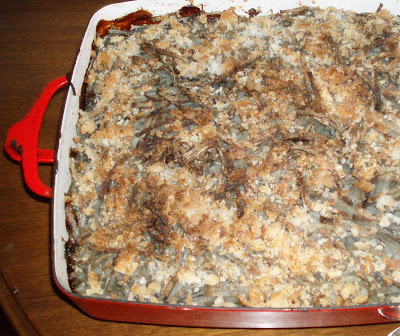
As I cast about the blogosphere, I can’t help but notice that, from coast to coast, 2009 weather has been unruly. It’s mid-July and still blazing hot in southern California and the desert Southwest. But the rest of the country is beginning to resemble Seattle, with overcast skies, midday drizzles, and lower than usual temperatures. The Upper Midwest is no exception. For a few days last week the high temps here in St. Paul hovered at 63 degrees, about twenty degrees below average. I’m not complaining. I like it cool, which is not to be confused with cold! I like to wear sleeves or long pants. I like to sleep under blankets. And, when it comes to cooking, I like to fire up the oven with impunity.
Since all those no-cook meals and whole-grain or pasta salad recipes that I had filed for hot-weather cooking are languishing, I thought I’d dip into the rib-sticking fare I associate firmly with winter. I preheated the oven to 375 degrees F and looked up a recipe for a favorite potato dish that we usually eat at Christmas, Jansson’s Temptation (Jansson’s frestelse).
I was first introduced to “the Jansson’s” in the late 90s. My brother-in-law, Will and his girlfriend, Helena, who is now his wife, would visit from their home in Sweden and prepare a Julbord with all the goodies they had smuggled in their suitcases. The smoked eel and smoked reindeer, the cornucopia of sill, and the countless varieties of aquavit were all treats, but the Jansson’s was the centerpiece of these sumptuous buffets. Rich with fragrant cream bubbling in the corners of a crusty top, Jansson’s can best be described as a potato casserole that gets a big boost from onions and anchovies (more on the anchovies, below), which are not immediately identifiable but give the dish an utterly unique and highly addictive quality.
Legend has it that the dish was created by the nineteenth-century opera singer, Pelle Janzon,

who, entertaining late one night, threw together everything he had in his pantry. According to wikipedia, the name was borrowed from a 1928 film, Jansson’s frestelse, and a dish created by the director's mother and her housekeeper, specially for the movie. Regardless, Jansson’s is one of the most iconic dishes in Swedish home cooking (husmanskost). It’s hearty, warming, and comforting, and tends to make an appearance at table as a main dish, rather than as a side, like potato gratin. Aside from the Julbord, Jansson’s is often serve at the end of many parties, especially wedding receptions. Judith Pierce Rosenberg writes in her wonderful book, A Swedish Kitchen, that Jansson’s is “traditionally meant to warm guests for the long sleigh ride back to their farms.”
Hambone and Spice ate Jansson’s recently for a number of reasons. We were cold. I had a tin of sprats fillets in the fridge and don’t know what else to do them. Also, we leave for Sweden next week, and I couldn’t wait until then for my fill of potatoes, onions, anchovies, and cream.
Jansson’s Temptation
A Swedish Kitchen (Judith Pierce Rosenberg)
serves 4
1 tablespoon butter
1 medium yellow onion, thinly sliced
4 medium Yukon Gold potatoes, peeled and cut into 1/4-inch wide matchsticks (5–6 cups)
1 (3-1/2 ounce) can anchovy-style sprats fillets in brine*
1/4 teaspoon salt
1/8 teaspoon white pepper
1-1/2 cups half-and-half
2 tablespoons dry bread crumbs
Preheat the oven to 375 degrees F. Grease a 2-quart baking dish. In a medium-size pan, melt the butter and sauté onions on medium heat until soft and translucent, about 10 minutes.
Cover the bottom of the baking dish with half of the potatoes, then add the onions. Place the anchovies, along with a little brine, on top of the onions. Cover the remaining potatoes.
Stir the salt and pepper into the half-and-half and pour over the potatoes. Sprinkle the breadcrumbs on top.
Bake until the potatoes are tender and the top is beginning to brown, about 45 minutes. Serve immediately.
*Do not thinly slice the potatoes as you would for a gratin. The matchstick cut lends a particular aesthetic to the dish. And, of course, it’s traditional, and I've been told that if you mess with this tradition, then the dish doens't taste the same.
** I will tell you straight away that anchovy sprats fillets are different from the Italian and French anchovies you find
 easily at the grocery store. Anchovy sprats are cured in a brine made of salt, sugar, and spices, such as cinnamon, sandalwood, and ginger, lending a very specific taste to Jansson’s and creating a perfect counterpoint to the smoked and cured meats and fish with which it’s served. Since Will and Helena no longer smuggle Swedish anchovies into the country when they visit, they’re often at a loss for an acceptable substitute. I live in a city with population that celebrates their Scandinavian heritage, and Ingebretsen’s Scandinavian Gifts and Imports on Lake Street carries anchovy sprats—and you can order them online. You may find other online sources, and it's worth the effort to look, but in a pinch, you can use oil-packed anchovies, which should be rinsed well and soaked in milk before using.
easily at the grocery store. Anchovy sprats are cured in a brine made of salt, sugar, and spices, such as cinnamon, sandalwood, and ginger, lending a very specific taste to Jansson’s and creating a perfect counterpoint to the smoked and cured meats and fish with which it’s served. Since Will and Helena no longer smuggle Swedish anchovies into the country when they visit, they’re often at a loss for an acceptable substitute. I live in a city with population that celebrates their Scandinavian heritage, and Ingebretsen’s Scandinavian Gifts and Imports on Lake Street carries anchovy sprats—and you can order them online. You may find other online sources, and it's worth the effort to look, but in a pinch, you can use oil-packed anchovies, which should be rinsed well and soaked in milk before using.
